 |
|
Here and There introduces art, artists, galleries and museums around Japan that non-Japanese readers and first-time visitors may find of particular interest. The writer claims no art expertise, just a subjective viewpoint acquired over many years' residence in Japan.
|
|
 |
|
|
 |
 |
Low Town Life: The Taito-ku Shitamachi Museum
Alan Gleason |
 |
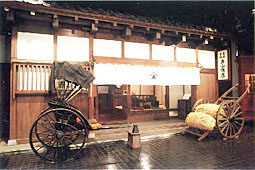 |
|
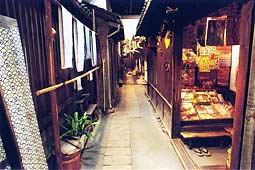 |
Rickshaw and cart parked in front of the hanao (footwear strap) shop, on the first floor of the Shitamachi Museum.
Photo courtesy of Shitamachi Museum |
|
Full-scale reproduction of a shitamachi tenement alley. The nagaya lifestyle remained relatively unchanged from the Edo era until the Kanto Earthquake of 1923.
Photo courtesy of Shitamachi Museum |
One of central Tokyo's 23 wards, Taito-ku contains some of the most historic sites and popular tourist destinations in the entire metropolis -- the museums and zoo in Ueno Park, the Asakusa entertainment district, Sensoji temple with its big red lantern. The area's reputation as an adult amusement mecca extends several centuries back into the Edo period, when it also contained the bustling Yoshiwara red-light district, backdrop to many a Kabuki play and ukiyo-e print.
Over the past century, Taito-ku has gone through some wrenching changes -- leveled by fire twice, after the Kanto Earthquake of 1923 and in the fire-bombings of 1945, then subject to rapid, often indiscriminate postwar development like the rest of the city. Yet the district has managed to hang on to some of the old flavor of the shitamachi once inhabited by plebeian Edoites. It has also displayed sufficient civic pride to build its own museum, with funding and exhibit materials donated by local residents, in homage to the shitamachi culture.
|
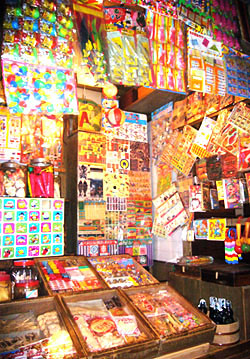 |
|
The dagashi shop, selling cheap candy, toys and games, was a fixture in most Tokyo neighborhoods until recently.
Photo by Alan Gleason |
Shitamachi literally translates as "low town," and this is often confused with the notion of "downtown" as in city center. But the term actually refers to ground elevation. It was the swampy lowlands at the head of Tokyo Bay, east of Edo Castle, that became populated with the burgeoning merchant and artisan classes under the Edo Shogunate, while the nobility preferred to live on higher ground to the west.
Most of the shitamachi consisted of nagaya, long wooden row houses that permitted little privacy and burned down frequently. Living in such close quarters, however, did engender an esprit-de-corps among Edoites that lingers in these neighborhoods today.
Taito-ku's Shitamachi Museum does a nice job of reproducing this atmosphere. Opened in 1980 by the ward government, the modest building looks out on a local landmark, Ueno Park's vast Shinobazu Pond. On a steamy August afternoon, the museum's second floor window offered a glorious view of acres of blooming lotuses covering the pond surface as far as the eye can see -- a sight that probably hasn't changed much in the last couple of hundred years.
|
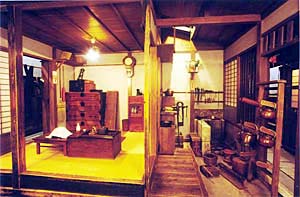 |
|
The coppersmith's workshop and adjoining living quarters.
Photo courtesy of Shitamachi Museum |
I nside, the museum makes efficient use of its limited floor space. The first floor is devoted to a permanent installation that lovingly reincarnates a typical Edo-era shitamachi block -- a coppersmith, a toy-and-candy shop, and a maker of sandal straps, with their respective attached living quarters. The narrow alleys between the shops give a sense of the friendly claustrophobia of these neighborhoods, and the vibe is so authentic that one forgets there is a roof overhead.
Upstairs, the lifestyles of Tokyo citizens in somewhat more recent times are depicted -- the entrance to a public bathhouse, a retro-looking Western-style bar, a cramped living room where a black-and-white TV set, circa 1960, occupies pride of place. Rotating displays of household items (donated by Taito-ku residents) from the pre- and postwar eras provide a poignant whiff of life in Tokyo during those trying times, during which citizens were buffeted between democracy and dictatorship, boom and bust, peacetime growth and wartime destruction.
There is nothing, however, like a focus on the personal to help us make sense of the big picture. Right now, in the midst of one of Tokyo's worst-ever heat waves, the museum has cleverly set up an exhibit of "Ways to Stay Cool in the Summer" -- from paper fans to Japan's first home-appliance air conditioner.
Though larger venues like the Edo-Tokyo Museum may offer more and grander dioramas of the city's life through the centuries, the Shitamachi Museum has the indubitable advantage of being located right smack in the shitamachi itself. Indeed, it makes the perfect jumping-off spot for a day's worth of touring some of Tokyo's best-preserved neighborhoods, all within walking distance of the museum.
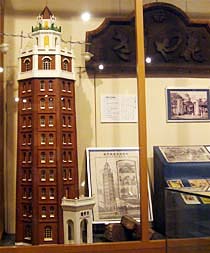 |
|
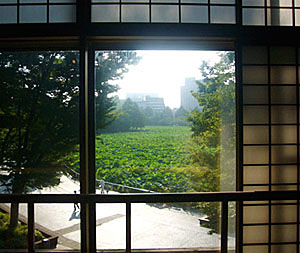 |
Scale model of Tokyo's first skyscraper: twelve stories high, the Asakusa Ryounkaku was built in 1890 but collapsed during the 1923 earthquake.
Photo by Alan Gleason |
|
The view of Shinobazu Pond on a midsummer day, from the second floor of the museum.
Photo by Alan Gleason |
|
|
|
|
|
|
 |
|
 |
Shitamachi Museum |
 |
|
|
Ueno-koen 2-1, Taito-ku, Tokyo
Phone: 03-3823-7451
Hours: 9:30 - 16:30, closed Mondays (except holidays) and December 29 - January 1
Transportation: Five-minute walk from Ueno Station (JR, Metro and Keisei lines) |
 |
|
|
 |
 |
Alan Gleason
Alan Gleason is a translator, editor and writer based in Tokyo, where he has lived for 25 years. In addition to writing about the Japanese art scene he has edited and translated works on Japanese theater (from kabuki to the avant-garde) and music (both traditional and contemporary). |
|
|
|
 |
|